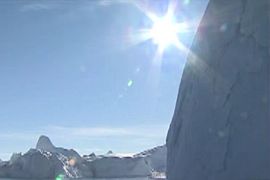Ice island breaks off into Arctic
Slab of ice four times the size of Manhattan calves off glacier in Greenland.

“Nobody can claim this was caused by global warming. On the other hand nobody can claim that it was not,” Andreas Muenchow, the professor of ocean science and engineering at the University of Delaware, said.
“The ice island has an area of 260sq km and a thickness up to half the height of the Empire State Building.”
|
“The freshwater stored in this ice island could keep the Delaware or Hudson Rivers flowing for more than two years” Andreas Muenchow, |
Scientists have said the first six months of 2010 have been the hottest globally on record.
The El Nino weather pattern has contributed to higher temperatures, but many scientists say elevated levels of man-made greenhouse gases are pushing temperatures higher.
Muenchow said he had expected an ice chunk to break off from the Petermann Glacier, one of the two largest remaining in Greenland, because it had been growing in size for seven or eight years, but he did not expect it to be so large.
“The freshwater stored in this ice island could keep the Delaware or Hudson Rivers flowing for more than two years,” Muenchow said.
“It could also keep all US public tap water flowing for 120 days.”
The ice island could fuse to land, break up into smaller pieces, or slowly move south where it could block shipping, Muenchow said.
The last time such a large ice island formed was in 1962 when the Ward Hunt Ice Shelf calved an island. Smaller pieces of that chunk became lodged between real islands inside Nares Strait.